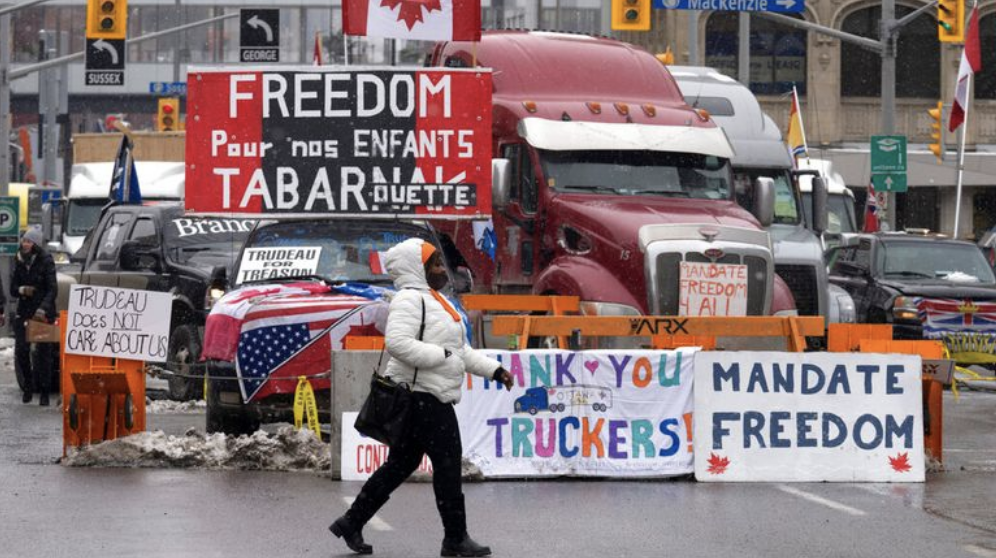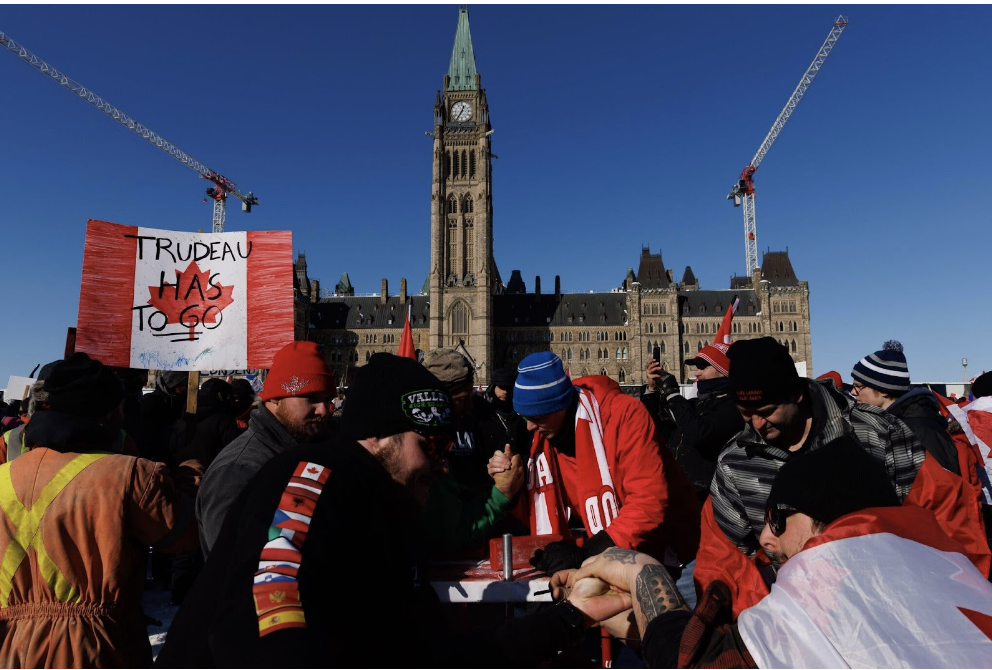OP-ED: Canadian Response to Trucker Convoy Reveals a Retrospective Need for Federal Authority
A woman walking by the trucker protests in Ottawa, Canada on February 8th. Source: Adrian Wyld / AP.
Three months ago, the streets of Ottawa, Canada, were littered with the machinery of freight-haulers and twenty-four hour cacophonous truck sirens. In a month-long battle, protestors occupied the downtown capital to the point where Trudeau’s government invoked unprecedented emergency measures to end their resistance. Now, as Canada launches an inquiry into its response against the Trucker protests, it must consider whether calling these emergency powers was necessary.
In his investigation, Justice Paul Roleau must come to realize that a national response to combat far-right violence is perhaps the only effective strategy for maintaining stability.
Canada’s Emergencies Act, which was first instituted in 1988, grants the federal government temporary capabilities to assume additional powers when a local government is unable to handle an emergency situation. A government declaration to invoke the Act must be supported through an act of parliament — which was partly completed in February 2022 — and last for less than a month. In the aftermath of the Act’s end, an inquiry must be established to review the government’s response.
Trudeau’s choice to utilize the act thereby gave the government the power to tow away trucks that were blocking Parliament, bridges, and streets throughout Ottawa. It also provided banks the ability to freeze the bank accounts of protestors, with warnings in advance, until the protests had ended. Nine days after initiating the Act, the government had succeeded in ending the blockade. A retrospective analysis of the unfolding events seemingly upholds the government’s decision as the best approach in unstable circumstances.
At its very root, the Trucker Convoy protests of Ottawa were primarily motivated by a combination of fierce government resistance and conspiracism. Truckers first began coalescing around the steps of the Canadian Parliament at the end of January as a response to new Canadian and American vaccine mandates. Despite constituting only a minority of the trucker industry, the usage of vehicles to disrupt economic and social activity quickly became a rallying cry for far-right operatives around the world to defy pandemic safety measures.
Inviting fringe ideas into mainstream politics proved to be a dangerous game. The federal government, while dismayed by the response, chose to first take a hands-off approach to the protests and delegate the response to the city and province. The conspiracy-laden “Freedom Convoy,” however, was adamantly opposed to negotiations unless a drastic rollback of pandemic measures could be achieved — a decision that would be overwhelmingly at odds with the public, and had little chance of passing.
The fundamental reality behind these appeals is that there was never an incentive for protestors to ever reduce their demands. Publicizing the protests in conspiracist circles gave opponents an influx of cash to sustain their resistance for months on end. Over $20 million in assets raised were frozen in light of the damage committed to businesses in Ottawa, with almost half the donations being brought in from outside of Canada.
Protestors stationed around Parliament Hill on January 29th. Source: Nasuna Stuart-Ulin / New York Times.
Opponents of Trudeau’s Emergency Powers decision direct their ire with the government’s response towards the overeagerness in instituting powers without considering necessary alternatives. “Governments already have the lawful authority to address difficult situations and do so all the time,” Canadian Civil Liberties Association Executive Director, Noah Mendelsohn Aviv, said in a statement on February 17th. The organization went on to sue the government for overreach in declaring its powers, and has remained critical of the inquiry.
These fears linger in the backdrop of all functional democracies, and it is important to raise these concerns whenever a government attempts to extend its power. The slippery slope posed by Trudeau’s decision, however, appears relatively unfounded in hindsight. Its scope was fairly limited in time — a total of nine days — and largely focused on cutting off external revenue to a select number of right-wing activists.
The government’s realizations of the existing system’s failure appears to be a central force in deciding to extend its powers beyond financial seizures. In a failure of municipal enforcement, Ottawa’s police force was completely incapable of controlling the sudden influx of right-wing protests. An indecisive, slow response allowed the protests to instead fester, despite illegal parking and protest violations.
Ottawa’s situation had already been devolving by the time emergency measures were called. In the days leading up to Trudeau’s announcement, 15,000 protestors had flooded the streets and began spilling into residential neighborhoods. Property crime accusations grew with the lack of enforcement. Over 400 hate-motivated incidents were reported by the second week of the protests, while fireworks, sirens, and chants disrupted residents.
Trudeau’s decision, therefore, appears to suggest a central concept — local police were making the same mistakes that had unfolded in the United States earlier. Without federal oversight, there was an increasing chance that Canada was about to commit the same errors that the United States made in responding to their own right-wing resistance.
Ultimately, the decision to use the Emergencies Act to quell the protests will likely not end the oncoming tide of populist, far-right protests in Canada. Neither will it provide accountability for the gaps in the local response, which must be bolstered to handle future protests. The central question instead must be whether the Prime Minister ascertained a credible threat to the state that no other level of government could handle.
Roleau’s inquiry must remain unbiased and willing to consider critiques of the administration’s response. Considering the lawless roots of the protests and the institutional indifference that accompanied it, Canada understood the need for a forceful, yet peaceful resolution. However, the release of additional documents to comply with the investigation may reveal more details about the government’s decision to choose such a broadly-encompassing response. In this regard, there may be more left behind the trucker movement that we have yet to understand.


